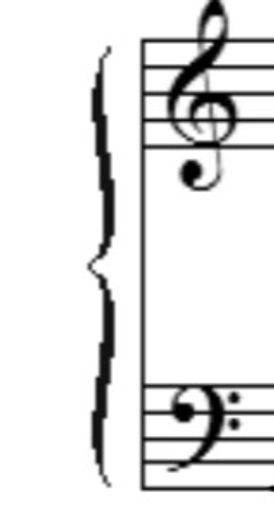Welcome
How to read music
No matter which instrument you wish to play; be it guitar, piano, violin, saxaphone, trumpet, whatever; all musical instruments use the same notation to tell you which note to play. This site uses the piano as an example to explain how to read music. Once you understand it, you can apply it to any other instrument.
Basic piano keyboard
Repeating Pattern of keys
Repeating Pattern of keys

The keyboard of a piano is made up of a series of black and white keys.
Repeating Pattern of keys
Repeating Pattern of keys
Repeating Pattern of keys

The black keys are arranged in a series of 3 black keys, then 2 black keys, then 3 black keys, then 2 black keys, and so on for the whole keyboard
Notes on the keyboard
Repeating Pattern of keys
Middle C - the very center of the piano

Doe, re, mi, fa, sol, la, ti, doe forms the first basic scale on the keyboard. It begins with C, plays all white keys and ends on the next C.
Middle C - the very center of the piano
Middle C - the very center of the piano
Middle C - the very center of the piano

Everything above Middle C is called Treble. Everything below Middle C is called Bass.
This is a Treble Clef
Middle C - the very center of the piano
This is a Treble Clef

To find a note on the keyboard you have to know if it is above or below Middle C. Notes written on the lines with the Treble Clef are above Middle C.
bass clef
Middle C - the very center of the piano
This is a Treble Clef

Notes written on the lines with the Bass Clef are found below Middle C.
THe Grand Staff
THe Grand Staff
THe Grand Staff

The Treble Clef lines combined with the Bass Clef lines makes the Grand Staff. Any note for any instrument can be located on the Grand Staff..
middle c
THe Grand Staff
THe Grand Staff

Notice the Grand Staff. Find the Bass Clef. Find the Treble Clef. Look at the diagram of the Keyboard. Notice the two black keys. The first white key to the left of the black key is always called C. And the C key in the middle of the keyboard is called Middle C. Middle C is located on the Grand Staff right between the Treble Clef and the Bass Clef.
Photo Gallery
Site Content
Whole note
Whole note rest
Whole note rest

Any note has a rhythmic value. That is, ‘how fast do you play the note?’ A whole note is a long sounding note and is held for the entire length of a measure.
Whole note rest
Whole note rest
Whole note rest

As a song gets played, sometimes there is a beat or two of silence. If no note is played, that is called a “REST”. This is a picture of a whole note rest.
Half note
Half note rest
Half note rest

A half note has 1/2 the value of a whole note. It has a head just like a whole note and it also has a stem. The whole note is the only note without a stem.
Half note rest
Half note rest
Half note rest

You can remember the difference between a half note rest and a whole note rest by thinking that it has less value and so can sit on top of the line. The whole note is longer (heavier) and sits below the line.
Site Content
Quarter note
Quarter note rest
Quarter note rest

A quarter note gets one beat. If a whole note is held for four beats, the quarter note, being one-fourth as long, will get held for just one beat.
Quarter note rest
Quarter note rest
Quarter note rest

If one beat of silence is to occur in a song, the quarter note rest is used. When you see it, stop playing any notes for one beat. The flag head faces right.
Eighth note
Quarter note rest
Eighth note rest

As a song picks up speed, the notes get played faster and faster. The eighth note gets 1/2 beat. It is played twice as fast as a quarter note.
Eighth note rest
Sixteenth not rest
Eighth note rest

The eighth note rest has a flag head pointing to the left. Stop playing music for 1/2 beat when you see this rest.
Sixteenth note
Sixteenth not rest
Sixteenth not rest

Now the song is moving really fast with this note. It has two flags and is played twice as fast as an eighth note. If there were four beats to a whole note, there would be sixteen of these. That’s really fast.
Sixteenth not rest
Sixteenth not rest
Sixteenth not rest

The song will not stop for long with the sixteenth note rest. Barely a hiccough. It’s fast. Note the two flag heads facing left.
A Simple Song

The keyboard is below. Notice the orange note on the staff. The orange key on the keyboard is the note you would play. Look at your chart of notes and name the other notes in the song.




more to come
Copyright © PatPreble 2019 - All Rights Reserved.
Powered by GoDaddy Website Builder